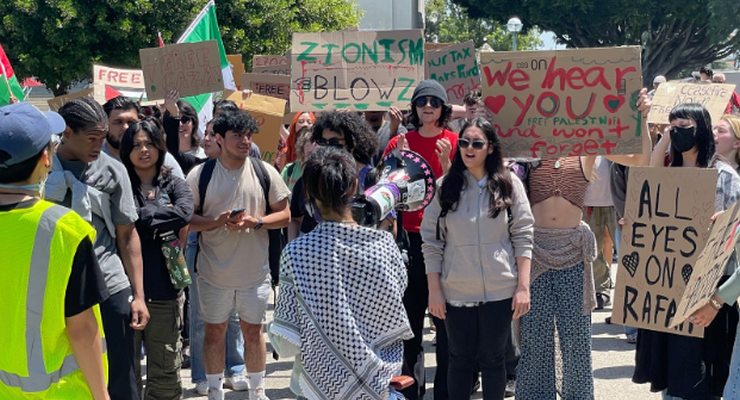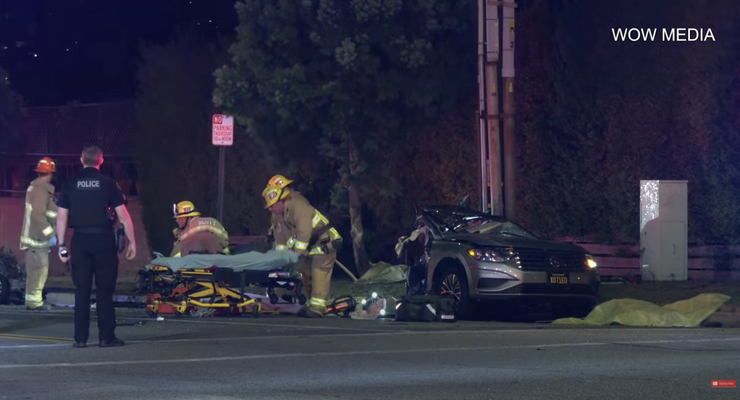The mood in von Karman Auditorium at the Jet Propulsion Laboratory (JPL) late Sunday night was overwhelmingly, almost deliriously, celebratory. The Mars Science Laboratory (MSL) rover, Curiosity, touched down safely on Mars at 10:32 p.m. PDT and minutes later relayed its first black-and-white thumbnail images back to Earth, showing one of its wheels firmly planted on Martian soil. During a postlanding press conference, a conga-line-type parade of team members wearing light-blue polo shirts streamed into and coiled around the auditorium, as each person high-fived the team managers at the front of the room. The entry, descent, and landing (EDL) team even started chanting, “E-D-L, E-D-L.”
 The Mars Reconnaissance Orbiter snapped this shot of the MSL spacecraft with its parachute deployed shortly before the rover’s successful landing. [Credit: NASA/JPL-Caltech/Univ. of Arizona]
The Mars Reconnaissance Orbiter snapped this shot of the MSL spacecraft with its parachute deployed shortly before the rover’s successful landing. [Credit: NASA/JPL-Caltech/Univ. of Arizona]
They had good reason to celebrate. Based on the first engineering data that has come back to Earth about the health and safety of the vehicle, the rover is operating according to plan after the harrowing EDL sequence, famously known as the “seven minutes of terror.”
Curiosity is a car-sized analytical laboratory on six wheels. The rover carries 10 scientific instruments, 16 cameras, and a radioisotope thermoelectric generator that can keep it powered for years to come. Its goal? To explore its landing site—an impact basin formed more than 3 billion years ago, called Gale Crater—for evidence of environments that either once were or now are habitable.
To get to this point, many people on the MSL team have worked eight or more years on the mission, in part trying to think of every potential problem Curiosity could encounter and then preparing the vehicle for such situations. But as landing night approached, the engineers and scientists of the mission had less and less control over the MSL spacecraft. And in the end, as much of the world sat on edge, waiting for a thumbs up or thumbs down from Curiosity, so too did the team.
 MSL took this photo of the spacecraft’s heat shield three seconds after it was deployed and about two and a half minutes before landing. The image was obtained by the Mars Descent Imager instrument known as MARDI. [Credit: NASA/JPL-Caltech/MSSS]
MSL took this photo of the spacecraft’s heat shield three seconds after it was deployed and about two and a half minutes before landing. The image was obtained by the Mars Descent Imager instrument known as MARDI. [Credit: NASA/JPL-Caltech/MSSS]
Perhaps that’s where the superstitions of landing day come in. In the mission control room at JPL on Sunday there were plenty of lucky peanuts to go around—a tradition that the team has indulged in for nearly 40 years, since the Ranger 7 mission. There was at least one “playoff beard,” there were lucky trinkets in hand, and Bobak Ferdowsi, the activity lead and flight director of the mission, let the team vote on his lucky coiffure for the event. (They went with a red-and-blue mohawk hairdo with stars shaved into the sides.)
But, of course, much more than luck guided Curiosity to a safe landing. The team had tested and retested every aspect of the vehicle and practiced the sequence many times. In briefings leading up to landing night, they repeatedly told reporters that they were confident in the spacecraft’s preparation, but there was always the caveat that landing on Mars is a risky business and many things could go wrong. As Adam Steltzner, the EDL phase lead at JPL put it on Sunday morning, “We’re rationally confident, emotionally terrified.”
As it turned out, everything went terrorlessly during the seven minutes. The Mars Odyssey orbiter flew over and established a good communication link with MSL as hoped, and the team was able to follow MSL’s progress toward the surface of Mars, sky-crane maneuver and all. Several members of the team said the evening even took on a surreal feeling, as though the whole thing was just a movie.
“It just was magical—everything went so smoothly,” said John Grotzinger, the chief scientist of the MSL mission and the Fletcher Jones Professor of Geology at Caltech, following the landing. “I had to just keep reminding myself it wasn’t a test anymore.”
If there was any remaining misgiving about the difficulty of the feat MSL had accomplished, President Obama’s science advisor, John Holdren, erased it before a cheering auditorium, telling onlookers that the landing was, “by any measure, the most challenging mission ever attempted in the history of robotic planetary exploration.” The applause grew even louder when he said, “If anybody has been harboring doubts about the status of U.S. leadership in space, well, there’s a one-ton, automobile-sized piece of American ingenuity, and it’s sitting on the surface of Mars right now.”
JPL director Charles Elachi took the conversation back to the Olympics. (Sports metaphors were prevalent throughout the run-up to the landing, with comparisons to not only the Olympics but also to the Super Bowl and a marathon.) “This team came back with the gold,” he said.
The first black-and-white images from the rover were themselves a prize for the engineers and scientists on the team, since they show an area of Mars no one has ever seen up close. They also provide evidence that the rover is alive and well on the surface of the red planet. And even though the very first images were low-resolution and taken with the hazard-avoidance cameras that still had their transparent dust covers on at the time, Grotzinger said of one image, “I think that is the best picture of Mars I’ve ever seen.”
No one knows exactly what Curiosity will find when she (as with ships, it has become common to refer to the rover as a female) begins her geologic investigation in earnest. Scientists hope she might identify organic compounds, those carbon-containing molecules that are necessary for life as we know it. For now, Curiosity is going through a number of engineering checkouts, running her first scientific activities, and taking and relaying images of her landing site to help the team pinpoint her location and better understand her surroundings. The team expects that it may be a couple of weeks before the rover goes for a short drive in Gale Crater and longer still before she scoops up her first soil sample.
 Curiosity’s front left hazard-avoidance camera snapped this full-resolution photo, which features the rover’s shadow, some dark sand dunes, and the three-mile-high Mount Sharp. Scientists have commented on the seemingly uniform grain size distribution of the pebbles on the ground. [Credit: NASA/JPL-Caltech]
Curiosity’s front left hazard-avoidance camera snapped this full-resolution photo, which features the rover’s shadow, some dark sand dunes, and the three-mile-high Mount Sharp. Scientists have commented on the seemingly uniform grain size distribution of the pebbles on the ground. [Credit: NASA/JPL-Caltech]
When she does, based on everything that is known about the landing site, those samples should be scientifically interesting. The rover touched down in between an alluvial fan—a geologic feature where debris from the rim of the crater might have collected—and a three-mile-high mountain of layered rock. That mountain—informally named Mount Sharp in honor of the late Robert Sharp, a Caltech geologist and former chair of the then Division of Geological Sciences—is the mission’s primary science target. The MSL team looks at Mount Sharp the way American geologist John Wesley Powell might have seen the Grand Canyon more than 140 years ago—as an exposed record of the planet’s history, preserved in rock form. That gives Curiosity an elegantly simple exploration model. As Grotzinger likes to say, “We’ll just start at the bottom of the mountain, interrogate the layers and make the measurements, and see what the planet’s trying to tell us.”
The MSL mission is also seen as a necessary precursor to any future manned missions to Mars. It has already shown that it is possible to deliver a metric ton of equipment to the surface of the red planet, and has measured the radiation environment experienced inside the spacecraft on the way there. As NASA administrator Charles Bolden said after landing, “Today, right now, the wheels of Curiosity have begun to blaze a trail for human footprints on Mars.”
The Mars Science Laboratory mission is managed by JPL for NASA’s Science Mission Directorate in Washington. Curiosity was designed, developed, and assembled at JPL, a division of Caltech.
Follow the mission on Facebook and on Twitter at http://www.facebook.com/marscuriosity and http://www.twitter.com/marscuriosity.
For information about the mission, visit http://mars.jpl.nasa.gov/msl/.













 0 comments
0 comments


